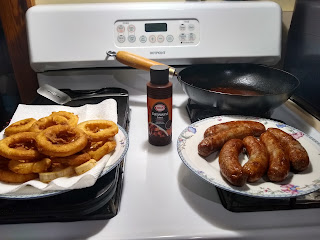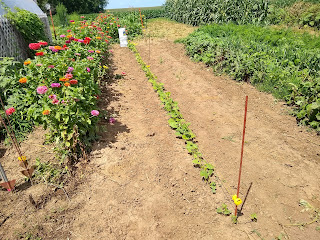Tool Time
The Farm Report
07-25-2023
 |
This is a lazy way out, but I'm trying to show you the Ruth Stout potato fork I use to 'pull' the onions. With this tool, I don't have to bend over. I use it to pick up potatoes, too. Ruth was the sister of Rex Stout - author of the Nero Wolf mystery books. Ruth was a character and a true master gardener. She pioneered the 'No Work' garden system of heavy mulch. She was a writer in her own rite, and published a number of garden books. If you don't know about her, or if you do and it has been a while since you've read her stuff, then it is time to do it. Refreshing and valid to this day. I love her attitude. She's been gone a long time, but her books are still available. You can actually see her in a Youtube interview. She always went on patrol in her garden carrying one of these little forks. I do, too. Click here to watch Ruth Stout |
 |
A bucket of onions! These are not keepers, but they are sweet and good. |
 |
That is MY fall garden. As you can see, Mr. Bunny Rabbit thought they were for HIS use. NO. That little yellow wire is my way of telling him that, too. |
 |
I make these little wind jammers from 2-liter soda bottles and a piece of bent wire. They make noise when the spin in the wind. I think it helps keep the 'coons and deer out of the garden at night. |
 |
I got the idea and copied the plan from Mr. Sam the Allotment Man on Youtube. You can learn a lot from Youtube. |
 |
This mess is the musk melon patch. I left 6 feet of space for them, but they've taken 12 or 15 feet! There are a lot of melons hiding down in there. I can't wait. |
 |
They're all over the internet. I think I got this one from eBay. |
 |
You just bend the wire, poke it through a hole in the plastic and then give it a kink with your pliers. Easy peasy. |




















Wow; you're talking like summer is nearing the end and we have at least two months to go, maybe longer! -- Michelle @ Boulderneigh
ReplyDeleteWell I'm just a realist, I guess. You know what they say about pessimists: A pessimist is just an optimist - with experience. It's all good!
DeleteI look forward to your monthly posts, I learn a lot so want to say thank you for taking the time.
ReplyDeleteGlad you're enjoying following along. I do enjoy the whole circle of it - both the 'doing' and the 'telling about it.' Cheers
DeleteGood golly, Tim, what a plethora of useful info! Loved this post. Ruth Stout was one of the first gardeners I studied when I first started gardening (some 104 years ago). I think of her every season because her sister (if I remember correctly) lived with her and her husband and prepared all their meals using the wonderful, fresh produce from Ruth's garden.. (Not having the time to spend in the kitchen creating fantastic meals straight from the garden is a real frustration for me.) I MUST get one of those "staplers" for tying up climbing vines. I spend way too much time using string and it's a task I dislike . . . a lot! I'd never heard of one of the tools you describe before. Thank you!
ReplyDeleteI've been a follower of Ruth Stout for as long as I can remember. Joyce and I used her hay (not straw!) mulch system when we were in Wisconsin nearly 25 years ago. The other day, as I walked past a book shelf, he 'No Work' gardening book jumped out at me and shouted my name. Re-reading it has been a hoot. Now, I've got ideas for next year. She had a major attitude that I love. Cheers.
DeleteThat's looking great! I like a push hoe, but need to make a narrower one..or find an antique as they used to be made! Have you ever tried a swoe?
ReplyDeleteI have not used a swoe. To me, it looks like a marketing excuse to sell a push hoe. Just my view. I have a small 'sickle section' hoe I made into a push hoe. It is about 2.5 inches wide. I find it is too narrow: the weeds slip off to one side. Overall, I think the most important thing is to get a tool that works for YOU. We're all (fortunately!) different. Thanks for following along. Cheers.
DeleteThanks for another GREAT newsletter, Tim!!! Dave & Sharlot
ReplyDelete